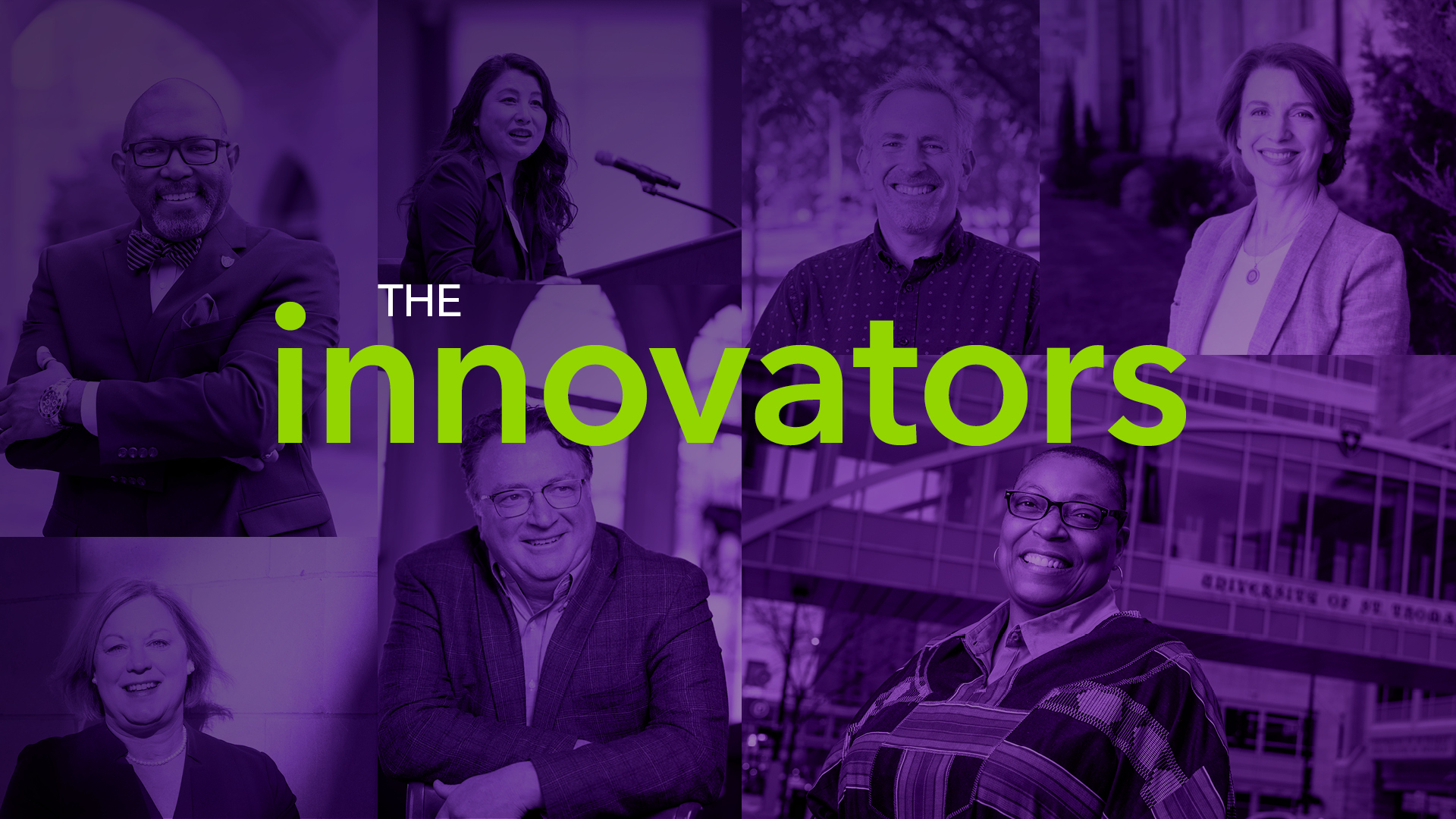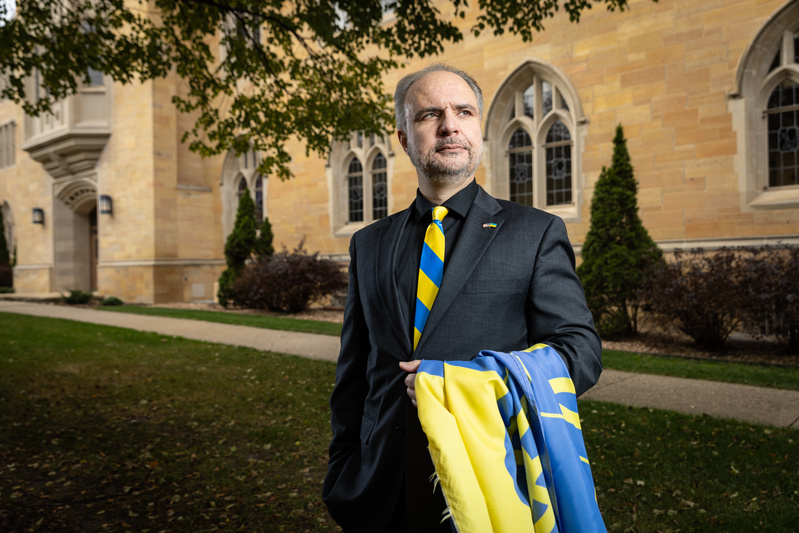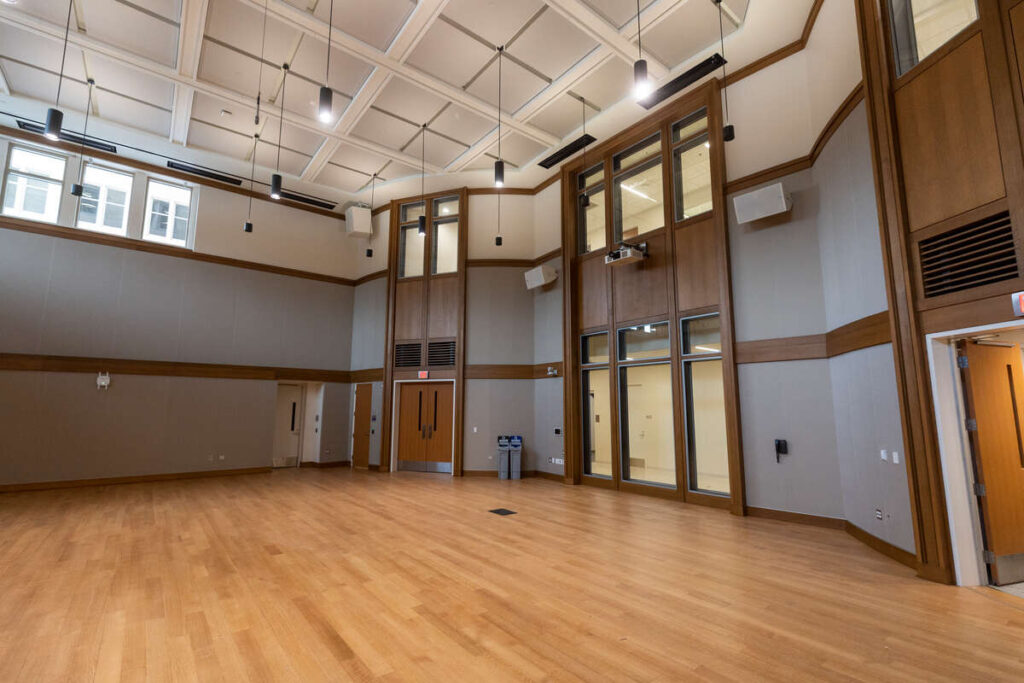A changing landscape in higher education spurs new ideas from new leaders at St. Thomas
New academic deans. A new head of enrollment. And, as we embark on a new year, even a new university president.
To say a new era of leadership is underway at the University of St. Thomas would be a slight understatement. The last year has brought a flurry of new leaders – some of whom are very familiar to St. Thomas – culminating in the Dec. 19 announcement of Rob Vischer as the university’s next president. They have arrived to helm various colleges, strategic initiatives and programs.
“This is a challenging time for higher education, there are very ominous economic headwinds in the higher ed marketplace,” said Vischer, who was dean of the law school before being tapped as interim president and now president, rising through the ranks since coming onboard as an associate professor in 2005. “We have what we need to meet those challenges, but to do so we really have to lean in on visibility, culture and outcomes.”
With an increasingly competitive higher education environment, the experts agree that today’s universities can’t afford to be stagnant – and St. Thomas certainly isn’t. Success depends on innovating with enrollment strategies, course curriculum and student engagement, as well as through advancing faculty experiences and opportunities.
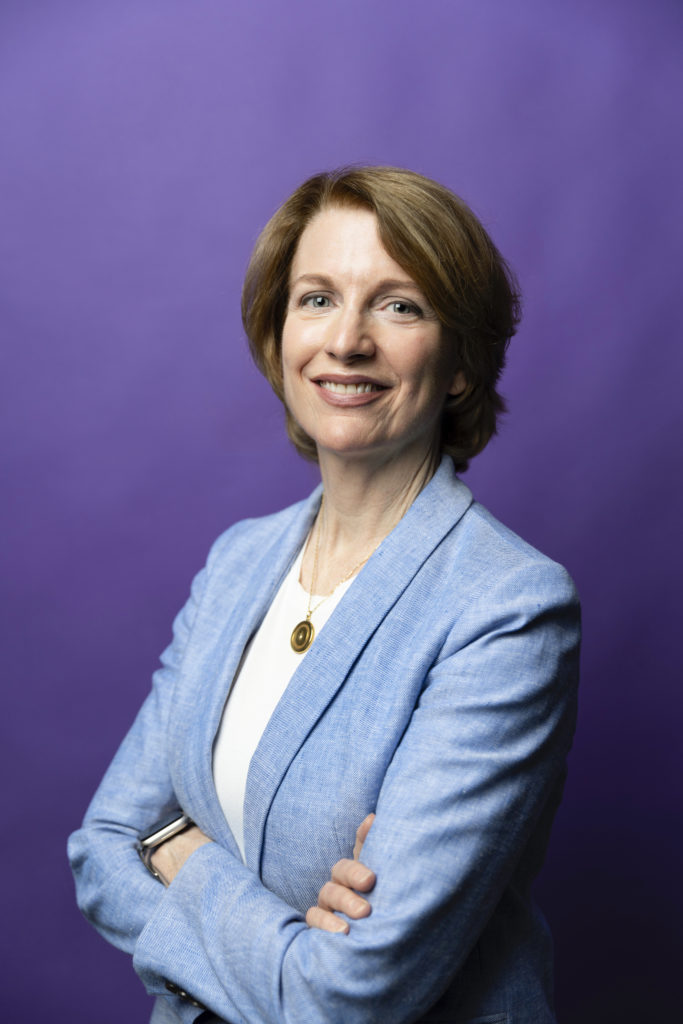
“Innovation is not something that we just do every couple of years to make sure we're staying up to date, it's an ongoing process,” Opus College of Business Dean Laura Dunham said. “We need to become much more nimble and much more entrepreneurial. Having more robust and agile innovation processes that allow us to embrace this notion of continuous change is going to be important.”
Dunham is one of three newly appointed deans at St. Thomas, promoted from her position leading the university’s Schulze School of Entrepreneurship to national prominence. Other leaders appointed this summer include Dr. Buffy Smith, promoted to dean of the Dougherty Family College after helming as interim dean and associate dean. And newcomers Dr. Bill Tolman, the dean of the College of Arts and Sciences, and Omar Correa, vice president for strategic enrollment management – both joined St. Thomas from other universities.
And it's not only recently appointed leaders charged with innovating. Continuing deans include Dr. MayKao Hang of the Morrison Family College of Health and Dr. Don Weinkauf of the School of Engineering. And Joel Nichols, who recently assumed the role of interim dean at the School of Law after serving as associate dean.
“For a business, we actually have a really exciting group of leaders, some of whom have been here for 20 years, and some of whom are brand new. Our leadership team across the university is composed of a mix of lifers and newbies, and that’s an exciting mix,” said Dr. Christopher Michaelson, the Opus Distinguished Professor of Principled Leadership, who has had a front-row seat during this process.
Michaelson, a nationally respected business expert with extensive knowledge of how executive changes can impact organizations, was tapped to serve on two high-profile search committees this year. In addition to excitement, he also expressed comfort in reaction to St. Thomas’ many leadership shifts.
“One reason we can take comfort during leadership transitions is that we have some clear governing principles,” Michaelson said. “Regardless of who the leaders are, those principles outlast our leaders.”
Postings for the positions gave good indications of those principles, which included a respect for Catholic intellectual tradition, a commitment to diversity and a desire to advance the common good.
The St. Thomas 2025 strategic plan also continues to stand as a guidepost for new and existing leaders, with room for innovation, Michaelson observed.
Always innovating
“There’s a lot of room in the higher ed space for leaders to innovate,” said educational leadership expert Dr. Jayne Sommers, who teaches in the School of Education. Interim Dean Dr. Amy Smith, who has a two-year appointment, leads the school.
“Good leaders require faculty and staff to think critically about how we've always done things and invite us to think innovatively. And obviously that is happening right now at St. Thomas,” Sommers said.
Executive Vice President and Provost Eddy Rojas – who’s also a St. Thomas newcomer – agrees.
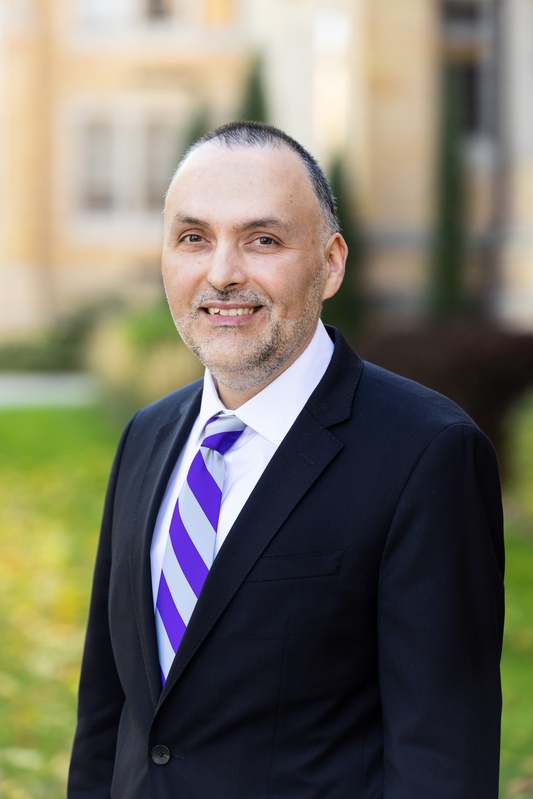
“The research that faculty do, changes to curriculum, advances in technology that’s implemented in the classroom or tools used for outreach for recruitment – all of this is innovation,” said Rojas, who joined St. Thomas in summer 2021.
“Innovation is also about keeping up with the times, staying ahead of the curve in a competitive environment,” he said. “It’s about knowing and understanding the factors at play in society that will motivate and engage students, as well as attract and retain excellent faculty and staff.”
For his part, Rojas is spearheading several new initiatives. For example, the Provost’s Office has launched St. Thomas Online, which offers a holistic strategy regarding distance learning education for students interested in pursuing online degrees. He has also implemented the SPEED (Strategic Program Evaluation, Execution, and Development) Team, which is tasked with accelerating the creation and launch of new interdisciplinary graduate programs.
“New leadership is an opportunity to fast-track innovation to enhance competitiveness,” he said.
At the College of Arts and Sciences, thinking innovatively and creatively is at the root of Tolman’s plans as dean.
The interdisciplinary nature of the college fuels innovative research and critical thinking among the faculty, which Tolman plans to continue.
“There's great stuff going on all across the arts, the humanities, the social sciences, the natural sciences and physical sciences,” he said. “What's distinctive about what happens in our college is this breadth of interaction, this ability to study things that are cross-disciplinary.”
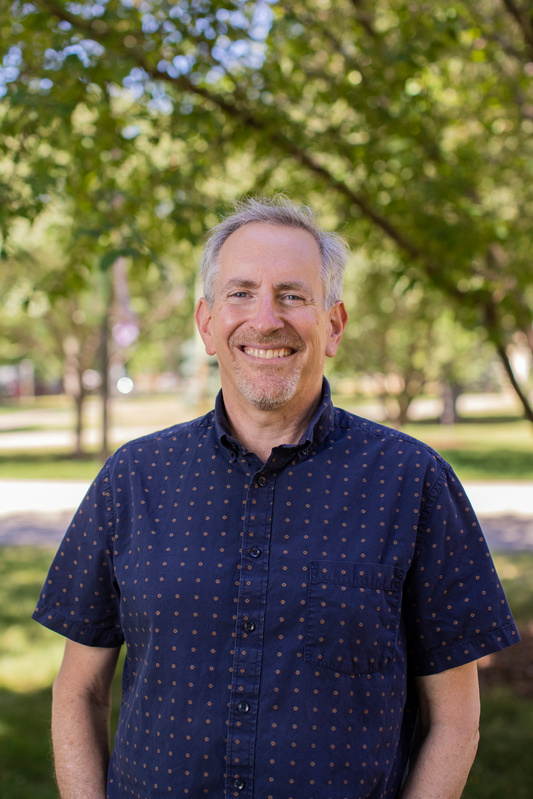
Tolman added, “Great faculty bring great students, and so, however we can enhance the support of faculty is going to impact our ability to attract and keep them and provide great experiences to our students.”
His plan includes direct support of experiential learning, including research, scholarship and creative practice through an endowed professorship.
“The innovative part,” he said, “is instead of the endowed chair sitting in one person's hands for some long, extended period of time, what we have in mind is using it to support multiple faculty for fixed terms, in a staggered way.” He adds that the professorship can be used as a tool to recruit and retain faculty.
Innovation thrives with diversity
Universities need to increase outreach to both nontraditional students and the racially underrepresented to stay competitive, experts say.
A 2022 article published in Forbes magazine states, “The pervasive issue in U.S. higher education has been and continues to be the decline in student enrollment.”
That statement is backed by a fall 2021 study from the National Student Clearinghouse Research Center. The study shows that postsecondary enrollment was down 2.6% nationally from the previous year for a total decrease of 5.8% from 2019. The root of this enrollment cliff is twofold: A decline in the U.S. birth rate and shifting racial demographics.
Enter Correa. As the new vice president of strategic enrollment management, he sees his charge as critical as St. Thomas looks to continue diversifying its student population.
“The most significant goal that has emerged for universities over the last two decades is to attract, retain and graduate diverse students who will enhance the fabric of their communities," said Correa, who brings 25 years of expertise in enrollment management.
“This goal can only be successfully achieved when the entire campus community is engaged and committed to a welcoming and inclusive environment for all,” he added. “The deans at all the schools and colleges at St. Thomas have made that commitment and made it a priority. In fact, our entire administration and admissions staff have made a commitment to have a more inclusive campus environment, welcoming in a greater number of underrepresented students.”
Progress is already being made, Correa said, pointing out that, “The seriousness of that commitment is reflected in the students you’ll see on our campus today.”
The enrollment final count from the fall semester at St. Thomas reveals that nearly one-third of all first-time, first-year Tommies enrolled for four-year and two-year degrees this fall identified as Black, Indigenous, or people of color (BIPOC), according to the university’s 10-day enrollment numbers. That is the most diverse freshman class in the history of the university.
At the Dougherty Family College, 96% of the students at the two-year college pursuing an associate degree are BIPOC – the highest number on record. Its faculty is equally diverse. DFC also has the highest two-year graduation rate of any college in the country. Additionally, 92% of DFC graduates from the Class of 2022 had $0 in student loan debt.
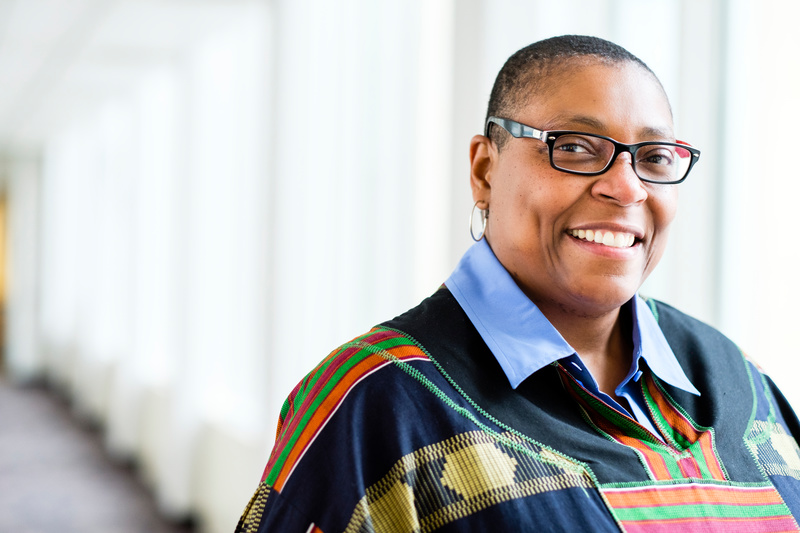
“DFC sets the standard for preparing historically underrepresented scholars to earn a future bachelor’s degree, get on the path to a meaningful professional career and step into their role as transformative community leaders,” said Smith, who climbed the ladder from founding associate dean of academics to interim dean and now as dean – all after more than a decade as a sociology professor in the College of Arts and Sciences.
Smith says that innovation is bold, transformative and working successfully at the cohort model college, which has secured the multiyear backing of local corporations, including U.S. Bank and 3M. The students even receive internships right after their first year, with a high percentage being hired by the companies where they interned once they obtain their bachelor’s degree.
“Experiential opportunities are one of the many ways we are transforming the higher education system,” Smith said. “We are doing our part to eliminate the educational attainment gap and create a more just and equitable world.”
Vischer agrees. “We have been on a journey from being a small Catholic liberal arts college to being a larger comprehensive Catholic university of national visibility and global impact,” he said. “We haven’t arrived at that destination yet, but we’re making tremendous progress, and this is going to be a key era for us to continue that journey.”
Overall, the university is in a good place with its new leaders. “It’s a really exciting mix that will bring new energy and timely ideas to the timeless, stable principles that are foundational to St. Thomas,” Michaelson said. “I would say we have a lot of opportunity ahead of us with this set of leaders.”
Editor’s note: Shortly before this edition of St. Thomas Magazine was distributed, Rob Vischer was named 16th president of the University of St. Thomas. Read the announcement here.
